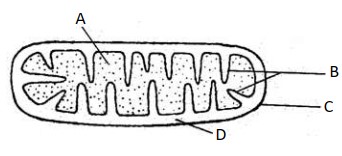Question 1
Name the causative agent of cholera.
Answer
Vibrio cholerae
Question 2.
The diagram below represents a cell organelle

(a) Identify the organelle.
(b) Name the part labelled B.
(c) State the function of part labelled A.
Answer
(a) Mitochondrion
(b) Cristae;
(c) Site where respiration occur;(habours respiratory enzymes)
(b) Cristae;
(c) Site where respiration occur;(habours respiratory enzymes)
Question 3
State the functions of the following parts of a light microscope.
(a) Condenser.
(b) Diaphragm
Answer
(a) Concentrates light from the source and directs it to specimen;
(b) Aperture below the condenser that regulates amount of light passing the condenser;
(b) Aperture below the condenser that regulates amount of light passing the condenser;
Question 4
(a) Explain three ways in which a red blood cell is adapted to its function
(b) In which form is carbon (IV) oxide transported
Answer
(a) - Have biconcave disc shape which increases the surface area for exchange of gases
by diffusion;
- Have haemoglobin which has high affinity for oxygen; (hence faster transportation of oxygen).
- Lacks nucleus to provide more room for packaging of haemoglobin;
(b) - Carbamino haemoglobin
- Carbonic acid
- Have haemoglobin which has high affinity for oxygen; (hence faster transportation of oxygen).
- Lacks nucleus to provide more room for packaging of haemoglobin;
(b) - Carbamino haemoglobin
- Carbonic acid
Question 5
State the functions of the following organelles.
(i) Centriole.
(ii) Nucleolus
Answer
(i) Centriole - Helps in formation ofspindle fibres;
(ii) Nucleolus - Helps in formation of ribosome’s;
(ii) Nucleolus - Helps in formation of ribosome’s;
